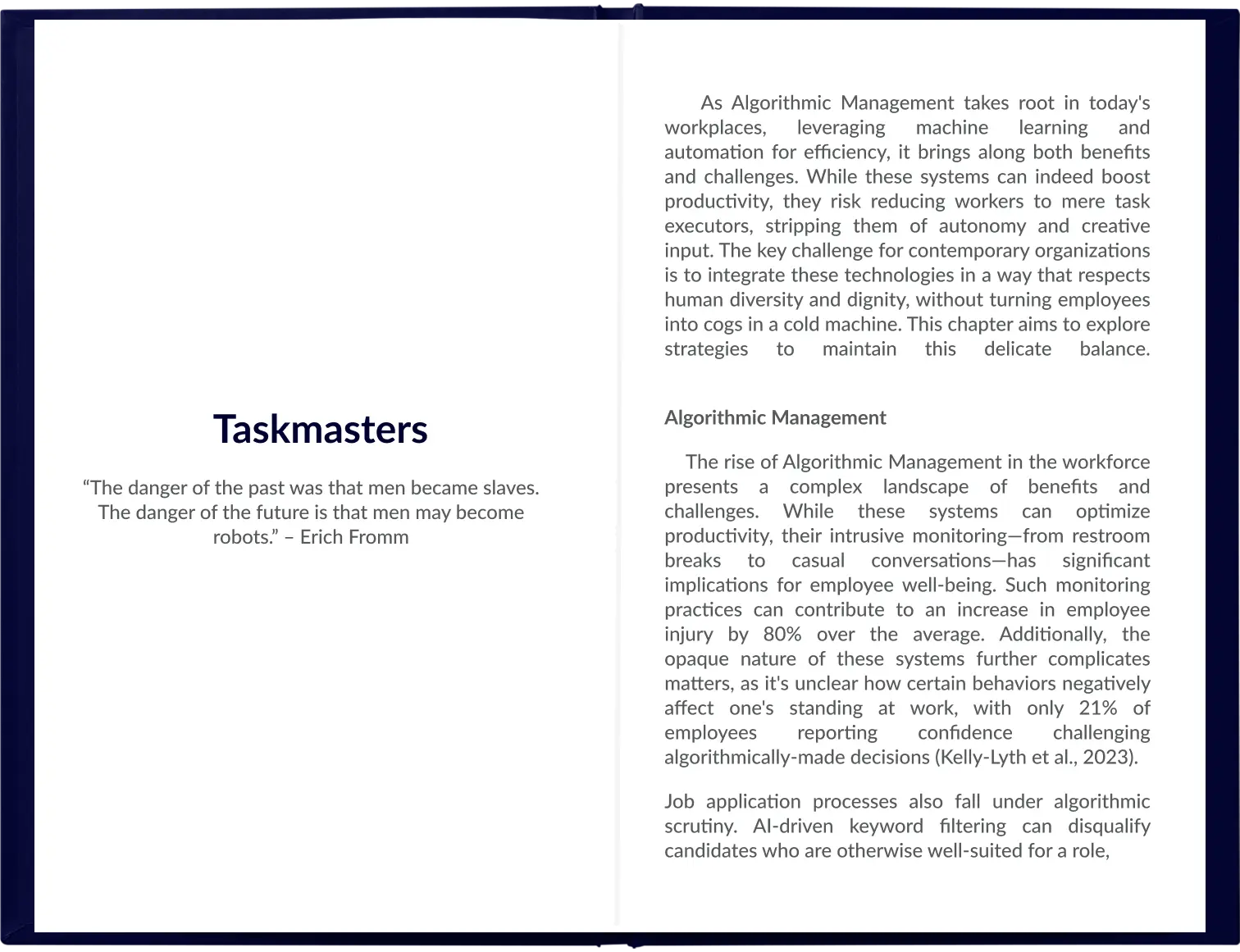Taming the Machine: Ethically Harness The Power of AI, Free Chapter to Read
You can read the ‘Taskmasters’ chapter of the book for free.

Taskmasters

As Algorithmic Management takes root in today’s workplaces, leveraging machine learning and automation for efficiency, it brings along both benefits and challenges. While these systems can indeed boost productivity, they risk reducing workers to mere task executors, stripping them of autonomy and creative input. The key challenge for contemporary organizations is to integrate these technologies in a way that respects human diversity and dignity, without turning employees into cogs in a cold machine. This chapter aims to explore strategies to maintain this delicate balance.
Algorithmic Management
The rise of Algorithmic Management in the workforce presents a complex landscape of benefits and challenges. While these systems can optimize productivity, their intrusive monitoring—from restroom breaks to casual conversations—has significant implications for employee well-being. Such monitoring practices can contribute to an increase in employee injury by 80% over the average. Additionally, the opaque nature of these systems further complicates matters, as it’s unclear how certain behaviors negatively affect one’s standing at work, with only 21% of employees reporting confidence challenging algorithmically-made decisions (Kelly-Lyth et al., 2023).
Job application processes also fall under algorithmic scrutiny. AI-driven keyword filtering can disqualify candidates who are otherwise well-suited for a role, turning the recruitment process into a dehumanizing game of buzzwords.
The impersonal nature of these systems makes them potentially tyrannical, exercising control without context, empathy or understanding. This is exacerbated by their complexity, which can reach a point where even their creators can’t fully explain their behavior. Once established, these systems are hard to roll back, risking the entrenchment of an inhumane work environment.
Unions could serve as a counterweight, evolving to defend traditional and gig workers against algorithmic injustices. The challenge of contesting algorithmic misattributions is also significant. When an algorithm judges an employee, the process behind that decision is often opaque. This can make it difficult for employees to challenge or even understand the basis for certain managerial decisions. It may also potentially lead to decisions which may be unfair and unlawful, systematizing discrimination on the grounds of religion or ethnicity. Transparency is crucial in addressing some of these issues, such as mandatory disclosure obligations covering not only the existence of such systems but also their scope of capability and deployment, and intended purposes.
Remote work adds another layer of complexity. Algorithms might not account for the unique challenges of a home workspace, such as family interruptions, leading to potential misunderstandings about an employee’s work ethic.
As we integrate these systems further, it’s essential to remember the labor rights we’ve fought hard to establish. The eight-hour workday and workers’ compensation were once revolutionary ideas. Today, the frontier is ethical algorithmic management, and addressing its challenges is imperative before it becomes too deeply ingrained to change.
Automation and Employment
AI’s impact on employment is evolving beyond just replacing manual labor to encompass intellectual tasks like data analysis and customer service. Unlike earlier technological shifts, AI threatens to monopolize intellectual work, potentially leaving humans with only basic manual and emotional tasks. This trend, known as the “enclosure of intellectual activity,” could de-skill the human labor force.
Algorithms are already guiding gig workers, often those with fewer rights, towards fragmented, short-term tasks. While this may not lead to widespread unemployment, it could change the nature of work in ways that make jobs less rewarding and services less effective. For instance, “gigification” could break work into disconnected tasks, eroding the satisfaction of long-term involvement. Moreover, algorithm-driven customer service may lack the nuance and understanding that human agents offer, leading to depersonalized and less effective solutions.
In the AI-driven work landscape, traditional roles could be reduced to a bare minimum, comprising mainly “Machine Wranglers,” who oversee automated systems, and “Liability Sponges,” tasked with handling failures. The alarming part isn’t merely job loss to automation but the transformation of remaining roles into robotic-like functions. Under algorithmic management, every action becomes scrutinized data, setting humans against machine-level performance metrics.
This scrutiny can force human workers to adopt machine-like behavior—constant availability, intense focus, and a preference for quantitative over qualitative metrics—to keep their jobs. The result is increased productivity gains for companies but potentially fewer benefits for workers.
Management decisions that were once human-led, such as scheduling and performance reviews, are increasingly delegated to algorithms. While efficient, these systems lack human qualities like empathy and understanding. Machine learning models, when trained using standard data-collection techniques, tend to evaluate rule violations more severely than human evaluators due to differences in how annotators encode norms of behavior versus hard facts (Balagopalan et al., 2023). Mere descriptions of a situation that may involve a technical rule violation according to specific standards are not enough to know whether it’s a true violation. For example, someone might be annotated as smoking a cigarette (a fact), but it’s probably not problematic if they are currently outside, being viewed through a window (a norm).
Machine-governed workplaces limit spontaneity, creativity, and room for minor errors. Every action becomes scrutinized data, reducing the space for individual discretion or learning opportunities that a human manager might offer.
This mechanization of management squeezes out room for spontaneity, creativity, and tolerable mistakes. Individual actions are reduced to data points for analysis, and the latitude for human discretion shrinks. In a twist of irony, as machines advance to mimic human cognitive functions, humans are pressured to abandon their unique qualities to meet the rigid standards set by these strict machines.
Workplace Safety
AI technologies like machine vision can enhance workplace safety by proactively identifying risks, such as unauthorized access or safety gear violations. These tools can also improve hiring, task design, and training. However, their deployment requires careful consideration of employee privacy and agency, especially in remote work settings where home surveillance becomes a concern.
Companies must maintain transparency and clear guidelines about data collection and usage to balance safety enhancements with individual rights. When thoughtfully implemented, these technologies can create a mutually beneficial environment of increased safety and productivity.
Co-Pilots & Meat Puppets
Technology historically transforms jobs rather than outright eliminating them. For instance, word processors changed secretaries into personal assistants, and radiology AI enhances rather than replaces radiologists. Roles requiring specialized skills, nuanced judgment, or real-time decision-making are less susceptible to full automation. However, as AI takes on more tasks, some people could become “meat puppets,” executing manual tasks under AI supervision, which deviates from the idealistic promise of AI freeing us for creative work.
Big Tech’s early adoption of AI has given it a competitive edge, leading to industry consolidation and new business models. In various sectors, humans are increasingly acting as conduits for AI—call center agents follow machine-generated scripts and salespeople receive real-time advice from AI.
In healthcare, while roles like nursing are considered irreplaceable due to their emotional and tactile aspects, AI “co-pilots” could handle tasks like documentation and diagnostics, thereby reducing the human cognitive involvement for non-essential tasks.
Cyborgs & Centaurs
The Cyborg and Centaur models describe two distinct frameworks for human-AI collaboration, each with its own advantages and limitations. In the Cyborg model, AI is seamlessly integrated into the human body or workflow, becoming an extension of the individual—akin to a prosthetic limb or cochlear implant. This deep integration blurs the boundary between human and machine, sometimes even challenging our notions of what it means to be human.
The Centaur model, on the other hand, emphasizes a collaborative partnership where both humans and AI contribute their unique strengths to a common objective. This is exemplified in chess, where “centaur” teams of humans and AI often outperform either humans or machines alone. In this setup, the human remains in the loop, making strategic decisions and providing emotional or creative input, while the AI focuses on computation, data analysis, or routine tasks. Here, the entities remain distinct, and their collaboration is clearly delineated.
In a business setting, the Centaur model promotes a collaborative partnership between AI and humans, each contributing their strengths to achieve common objectives. For instance, in data analysis, AI could process large datasets to identify patterns, while human analysts apply contextual understanding to make strategic decisions. In customer service, chatbots could manage routine queries, leaving complex, emotionally nuanced issues to human agents. Such divisions of labor optimize efficiency, while augmenting human capabilities rather than replacing them. Maintaining a clear delineation between human and AI roles also aids in accountability and ethical governance.
Worker-led co-design
Worker-led co-design is an approach that involves employees in the development and refinement of algorithmic systems that will be used in their workplace. This participatory model allows workers to have a say in how these technologies are implemented, thereby ensuring that the systems are attuned to real-world needs and concerns. Co-design workshops can be organized where employees collaborate with designers and engineers to outline desired features and discuss potential pitfalls. Employees can share their expertise about the nuances of their job, flag ethical or practical concerns, and help shape the algorithm’s rules or decision-making criteria. This can make the system more fair, transparent, and aligned with workers’ needs, reducing the risk of adverse effects like unjust penalties or excessive surveillance. Moreover, involving employees in co-design can foster a sense of agency and ownership, potentially easing the integration of new technologies into the workplace.
C-Suite AI
AI holds the potential to substantially augment executive functions by rapidly analyzing complex data related to market trends, competitor behavior, and personnel management. For instance, a CEO could receive succinct, data-driven recommendations on acquisitions and partnerships from an AI advisor. However, AI currently can’t replace the human qualities essential for leadership, such as trustworthiness and the ability to inspire.
Additionally, the rise of AI in management can have social implications. The erosion of middle management roles due to automation could lead to identity crises, as the traditional understanding of “management” undergoes a transformation.
In management consultancy, AI has the potential to disrupt by providing data-backed strategic advice. This could even lend a perceived objectivity to tough decisions, like downsizing. However, the deployment of AI in such critical roles demands careful oversight to validate their recommendations and mitigate associated risks. Striking the right balance is crucial: underutilizing AI might mean missing out on transformative benefits, while overreliance could risk ethical and public relations pitfalls.
Servant Leadership by Machines
AI holds the promise of transforming the workplace by taking over mundane and repetitive tasks, potentially freeing humans to engage in more creative and intellectual pursuits. While algorithmic management is often criticized for eroding human autonomy, it could, ironically, enable a model where employees have greater freedom in achieving their objectives. The idea of “life on a rail” may sound restrictive, but for many, the delegation of small decisions could be liberating, allowing them to focus on more meaningful tasks.
AI is already making significant strides in various service sectors. In customer service, chatbots like Intercom handle routine queries, while in healthcare, algorithms assist in diagnostics and risk prediction. Financial robo-advisors like Wealthfront automate investment advice, and in retail, systems like Amazon Go are revolutionizing inventory and checkout processes. AI-powered platforms are also streamlining legal research and personalizing education. Even in transportation and hospitality, semi-autonomous vehicles and AI concierges are beginning to take on roles traditionally filled by humans. Just as technological advances in manufacturing led to an array of affordable, high-quality goods, AI has the potential to similarly revolutionize the service sector.
Public Service Management Failures
The deployment of AI and algorithmic systems in public service sectors like social welfare, education, and labor holds the promise of efficiency but also carries the risk of severe unintended consequences. For instance, Denmark’s use of an algorithmic system to manage unemployment benefits led to incorrect benefit cuts, turning what was supposed to be a time-saving measure into an administrative burden (Geiger, 2023). Similar issues occurred in Italy and Spain, affecting the allocation of teaching assignments and worker oversight, respectively (Bizzini, 2023) (Arandia et al., 2023). These cases are cautionary tales that emphasize the need for careful planning, thorough testing, and ethical consideration when implementing algorithmic systems in areas with significant human and social stakes. Errors in these sectors can have far-reaching impacts, affecting the livelihoods and well-being of individuals and communities. Therefore, contingency plans and human oversight are crucial to mitigate the risks associated with automating complex government administrative tasks.
Checking Out & Lying Flat
The current societal mood can be characterized by a sense of social defeat, stemming not from individual failures but systemic imbalances. This mood is exacerbated by economic shifts, such as the decline of manufacturing jobs, the rise of the gig economy, and the impact of neoliberal policies focused on efficiency. These shifts have led to reduced wages and limited opportunities for upward mobility, affecting particularly younger generations who have also had to deal with the great recession, the pandemic, and spiraling costs of living. Now, AI and automation are adding another layer of complexity by hollowing out both technical and creative industries and increasing workplace surveillance.
This overall context is leading to a growing discontent that sometimes results in public rage or social withdrawal. The current trajectory highlights the urgent need for intentional decisions aimed at improving collective morale and societal unity. As we see increasing numbers of highly skilled individuals opting out of contributing their talents, the parallels with the societal apathy observed during the declining years of the USSR become stark. To counteract this trend, targeted societal and policy interventions are necessary to foster a more equitable and satisfying future.
Given this backdrop, there’s a pressing need for purposeful decisions aimed at improving collective morale and societal cohesion. The current trajectory is not sustainable if the aim is a more equitable and fulfilling future. The irony that the present AI waves are automating creative expression instead of jobs that everybody hates shouldn’t be lost on us. Therefore, policymakers, technologists, and community leaders must work together to address these systemic issues, focusing on equitable growth and social well-being.
The Bottom line
The future of work is at a crucial inflection point. As AI technologies advance, the risk of amplifying existing ethical and social issues in the workforce grows. Ironically, ‘fulfillment centers’ often aren’t very fulfilling, and autonomous systems can usurp autonomy from human beings. There is an urgent need for a balanced approach that maximizes efficiency and innovation while safeguarding human dignity, autonomy, and well-being.
The Big Picture
The challenge of algorithmic management is to harness the power of AI to elevate human potential rather than diminish it. A light touch is essential if such tools are not to be a repressive yoke upon human beings. Such technologies must demonstrate that they are trustworthy, unbiased, and designed to serve the workers’ needs first, and not their paymasters. Leaders should avoid ruthless automation. Life is often at its best when it’s not too ‘optimized’ and when we take time to appreciate the small things.
Leadership Action Points
- Develop a governance framework for ethical AI use that prioritizes human well-being and addresses bias, fairness, and surveillance issues. Ensure that AI and algorithmic management systems are designed to augment human capabilities and are aligned with workers’ needs and ethical principles.
- Create transparent processes for algorithmic decision-making. Workers should know how algorithms impact their work, and mechanisms should be in place for them to contest decisions made by algorithms.
- Equip line managers and staff with the knowledge and tools to handle data and algorithms responsibly. This includes training on algorithmic management’s ethical implications and health risks associated with it. Algorithms should augment, not replace, human managers.
- Implement ongoing audits of AI systems to assess their impact on workers and the organization. Use the insights for continuous improvement and ethical alignment.
- Recognize and address the psychological and societal impacts of algorithmic management and work automation, advocating for mental health support and work-life balance.
References:
Arandia, P J et al (2023) Spain’s AI doctor, Lighthouse Reports, 17 April, www.lighthousereports.com/investigation/spains-ai-doctor (archived at https://perma.cc/WZ5Q-XBJJ)
Balagopalan, A et al (2023) Judging facts, judging norms: Training machine learning models to judge humans requires a modified approach to labeling data, Science Advances, 9 (19), https://doi.org/10.1126/sciadv.abq0701 (archived at https://perma.cc/SM28-YPWM)
Bavishi, R et al (2023) Fuyu-8B: A multimodal architecture for AI agents, Adept, www.adept.ai/blog/fuyu-8b (archived at https://perma.cc/SX6M-BXHZ)
Bizzini, P (2023) The algorithm that blew up Italy’s school system, Algorithm Watch, 17 April, https://algorithmwatch.org/en/algorithm-school-system-italy (archived at https://perma.cc/K8J5-G5SX)
Geiger, G (2023) How Denmark’s welfare state became a surveillance nightmare, Wired, 7 March, www.wired.com/story/algorithms-welfare-state-politics (archived at https://perma.cc/V93N-X98W)
Kelly-Lyth, A and Thomas, A (2023) Algorithmic management: Assessing the impacts of AI at work, European Labour Law Journal, 14 (2), 230–52

Order Your Copy Today
Step into the future and supercharge your performance safely by Taming the Machine.
Also available via:



